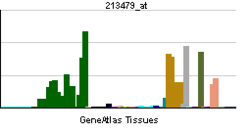NPTX2
| NPTX2 | |||||||||||||||||
|---|---|---|---|---|---|---|---|---|---|---|---|---|---|---|---|---|---|
| Identifiers | |||||||||||||||||
| Aliases | NPTX2, NARP, NP-II, NP2, neuronal pentraxin 2 | ||||||||||||||||
| External IDs | MGI: 1858209 HomoloGene: 1892 GeneCards: NPTX2 | ||||||||||||||||
| |||||||||||||||||
| RNA expression pattern | |||||||||||||||||
 | |||||||||||||||||
| More reference expression data | |||||||||||||||||
| Orthologs | |||||||||||||||||
| Species | Human | Mouse | |||||||||||||||
| Entrez | |||||||||||||||||
| Ensembl | |||||||||||||||||
| UniProt | |||||||||||||||||
| RefSeq (mRNA) | |||||||||||||||||
| RefSeq (protein) | |||||||||||||||||
| Location (UCSC) | Chr 7: 98.62 – 98.63 Mb | Chr 5: 144.55 – 144.56 Mb | |||||||||||||||
| PubMed search | [1] | [2] | |||||||||||||||
| Wikidata | |||||||||||||||||
| View/Edit Human | View/Edit Mouse |
Neuronal pentraxin-2 is a protein that in humans is encoded by the NPTX2 gene.[3][4]
Function
This gene encodes a member of the family of neuronal petraxins, synaptic proteins that are related to C-reactive protein. This protein is involved in excitatory synapse formation. It also plays a role in clustering of alpha-amino-3-hydroxy-5-methyl-4-isoxazolepropionic acid (AMPA)-type glutamate receptors at established synapses, resulting in non-apoptotic cell death of dopaminergic nerve cells.[4]
Clinical significance
Up-regulation of this gene in Parkinson disease (PD) tissues suggests that the protein may be involved in the pathology of PD.[4]
References
- ↑ "Human PubMed Reference:".
- ↑ "Mouse PubMed Reference:".
- ↑ Hsu YC, Perin MS (Feb 1996). "Human neuronal pentraxin II (NPTX2): conservation, genomic structure, and chromosomal localization". Genomics. 28 (2): 220–7. doi:10.1006/geno.1995.1134. PMID 8530029.
- 1 2 3 "Entrez Gene: NPTX2 neuronal pentraxin II".
Further reading
- Park JK, Ryu JK, Lee KH, et al. (2007). "Quantitative analysis of NPTX2 hypermethylation is a promising molecular diagnostic marker for pancreatic cancer.". Pancreas. 35 (3): e9–15. doi:10.1097/MPA.0b013e318153fa42. PMID 17895837.
- Marui T, Koishi S, Funatogawa I, et al. (2007). "No association between the neuronal pentraxin II gene polymorphism and autism.". Prog. Neuropsychopharmacol. Biol. Psychiatry. 31 (4): 940–3. doi:10.1016/j.pnpbp.2007.02.016. PMID 17408830.
- Poulsen TT, Pedersen N, Perin MS, et al. (2006). "Specific sensitivity of small cell lung cancer cell lines to the snake venom toxin taipoxin.". Lung Cancer. 50 (3): 329–37. doi:10.1016/j.lungcan.2005.06.011. PMID 16115696.
- Gerhard DS, Wagner L, Feingold EA, et al. (2004). "The Status, Quality, and Expansion of the NIH Full-Length cDNA Project: The Mammalian Gene Collection (MGC)". Genome Res. 14 (10B): 2121–7. doi:10.1101/gr.2596504. PMC 528928
 . PMID 15489334.
. PMID 15489334. - Hillier LW, Fulton RS, Fulton LA, et al. (2003). "The DNA sequence of human chromosome 7". Nature. 424 (6945): 157–64. doi:10.1038/nature01782. PMID 12853948.
- Scherer SW, Cheung J, MacDonald JR, et al. (2003). "Human Chromosome 7: DNA Sequence and Biology". Science. 300 (5620): 767–72. doi:10.1126/science.1083423. PMC 2882961
 . PMID 12690205.
. PMID 12690205. - Strausberg RL, Feingold EA, Grouse LH, et al. (2003). "Generation and initial analysis of more than 15,000 full-length human and mouse cDNA sequences". Proc. Natl. Acad. Sci. U.S.A. 99 (26): 16899–903. doi:10.1073/pnas.242603899. PMC 139241
 . PMID 12477932.
. PMID 12477932. - Kirkpatrick LL, Matzuk MM, Dodds DC, Perin MS (2000). "Biochemical interactions of the neuronal pentraxins. Neuronal pentraxin (NP) receptor binds to taipoxin and taipoxin-associated calcium-binding protein 49 via NP1 and NP2". J. Biol. Chem. 275 (23): 17786–92. doi:10.1074/jbc.M002254200. PMID 10748068.
- Dodds DC, Omeis IA, Cushman SJ, et al. (1997). "Neuronal pentraxin receptor, a novel putative integral membrane pentraxin that interacts with neuronal pentraxin 1 and 2 and taipoxin-associated calcium-binding protein 49". J. Biol. Chem. 272 (34): 21488–94. doi:10.1074/jbc.272.34.21488. PMID 9261167.
This article incorporates text from the United States National Library of Medicine, which is in the public domain.